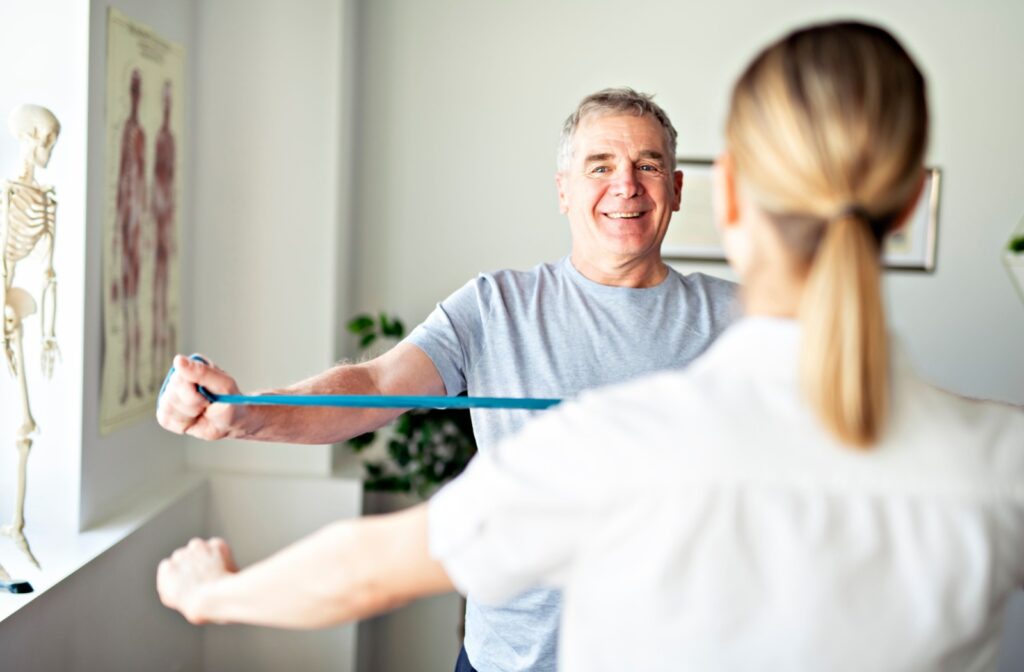When you’re living with pain, stiffness, or limited mobility, it’s natural to seek real, lasting relief. Many people turn to physiotherapy—but does it actually work? With mixed messages online and plenty of personal opinions, it’s easy to feel uncertain.
The short answer is yes—physiotherapy can be highly effective, especially when tailored to your individual needs and guided by a skilled provider. Let’s take a closer look at how it works, what to expect, and why it remains a cornerstone of rehabilitation and preventive care.
What Is Physiotherapy?
Physiotherapy, also known as physical therapy, is a healthcare discipline focused on restoring function, reducing pain, and improving quality of life through noninvasive techniques. These techniques can include:
- Manual therapy (hands-on joint or soft tissue manipulation)
- Exercise therapy
- Education and postural guidance
- Modalities like heat, cold, ultrasound, or electrical stimulation
- Breathing and relaxation strategies
- Neuromuscular re-education
A registered physiotherapist assesses your condition and creates a personalized treatment plan to address the root cause—not just the symptoms—of your pain or limitation.
How Does Physiotherapy Work?
Here’s why physiotherapy is effective: This treatment is evidence-based, meaning it’s supported by clinical research. Numerous studies have shown that physiotherapy can effectively treat a range of musculoskeletal, neurological, and post-surgical conditions. These include:
- Low back pain
- Neck and shoulder stiffness
- Tendonitis and overuse injuries
- Post-operative rehabilitation
- Sports injuries
- Arthritis
- TMJ dysfunction
- Pelvic floor disorders
- Neurological conditions like stroke or Parkinson’s
What makes physiotherapy successful is its holistic, whole-body approach. Instead of only treating the site of pain, a physiotherapist looks at how different parts of your body interact. A sore knee might be connected to hip weakness or ankle instability, so treating only the knee won’t provide long-term relief.
Common Misconceptions About Physiotherapy
1. “Physiotherapy didn’t work for me.”
Often, this is due to a mismatch between the treatment plan and the patient’s specific needs, or a lack of consistency with prescribed exercises. Physiotherapy isn’t a quick fix—it requires active participation and ongoing communication between patient and provider.
2. “It’s just stretches and massage.”
While stretching and manual therapy can be part of treatment, physiotherapy involves much more. Education, biomechanics, functional strength training, and lifestyle adjustments play critical roles in recovery.
3. “If it hurts, it must be bad for me.”
While physiotherapy should not cause significant discomfort, this isn’t entirely true. Which brings us to a common question…
Can Your First Physiotherapy Appointment Cause Pain?
Yes—it’s possible to feel sore after your initial visit. But that doesn’t mean something went wrong. During your first appointment, your physiotherapist may assess your joint movement, strength, and muscle tension. These movements, especially if you haven’t used those muscles in a while, can cause temporary discomfort.
In some cases, the therapist might introduce gentle exercises or manual therapy that trigger muscles to “wake up” and begin healing. Soreness after physiotherapy is often a sign that your body is beginning to adapt. Think of it like starting a new workout—there’s bound to be some reaction as your body adjusts.
If the pain is sharp, increases significantly, or doesn’t subside within a day or 2, you should reach out to your provider to adjust your plan.

What Makes Physiotherapy So Effective?
It’s Tailored to You
No 2 bodies—or injuries—are the same. A physiotherapist designs a treatment program that targets your exact condition, activity level, and goals. Whether you’re recovering from an accident or trying to improve posture at a desk job, therapy is built around your lifestyle.
It Promotes Long-Term Healing
Unlike quick fixes like painkillers, physiotherapy aims to correct the source of the problem. It strengthens weak areas, rebalances muscles, and retrains movement patterns to prevent recurring injury.
It’s Collaborative
Education is a huge part of treatment. You’ll learn about your condition, how to move better, and how to support healing at home. This empowers you to take an active role in your recovery.
It prevents Future Issues
Even if you’re not currently in pain, physiotherapy can improve mobility, posture, and core strength to prevent injury down the line. It’s a proactive investment in your health.
FAQs About Physiotherapy
Q: How long does it take to see results?
A: This depends on your condition and how consistently you follow your treatment plan. Many patients notice improvements within a few sessions, while others may need several weeks or months for full recovery.
Q: Do I need a referral from a doctor?
A: In Alberta, you can see a physiotherapist without a referral. However, some insurance plans may require a referral for reimbursement, so check with your benefits provider first.
Q: Is physiotherapy covered by insurance?
A: Yes—most extended health plans in Canada cover physiotherapy. Check with your insurer to understand your coverage, limits, and whether direct billing is available.
Q: What should I wear to my appointment?
A: Comfortable, loose-fitting clothes are best—anything that allows easy access to the area being treated and freedom of movement.
Q: Can physiotherapy help with chronic pain?
A: Absolutely. Chronic pain often stems from compensatory movement patterns or unresolved injuries. Physiotherapists can help identify the root cause, reduce pain, and teach you strategies to manage symptoms long-term.
The Bottom Line: Physiotherapy Works
Physiotherapy is not just for athletes or post-surgery patients, it’s for anyone looking to move better, live with less pain, and support their long-term well-being. It’s backed by science, tailored to the individual, and focused on restoring function from the inside out.
At Running Shoe Restorative Healthcare in Calgary, our skilled physiotherapists work with you to create a plan that fits your goals and respects your body. Whether you’re recovering from an injury, dealing with chronic pain, or simply hoping to feel more balanced in your daily life, we’re here to help. Book your appointment today and take your next step toward healing.





